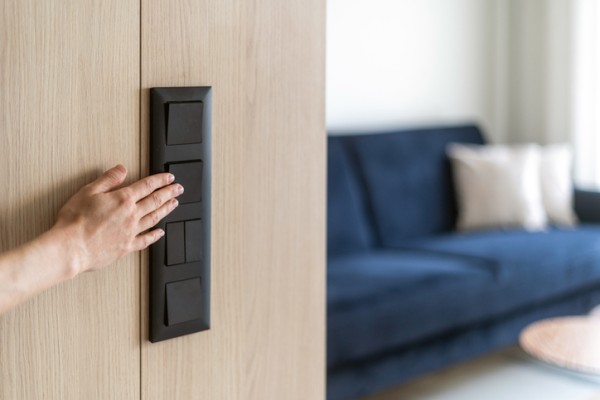
Light switches might not seem like a big design choice, but they’re one of the most frequently touched and seen components in any home. Whether you’re building new, renovating or simply updating a room, the style of your light switches can affect both how a space looks and how easily it functions.
From traditional toggles to smart touchscreens, the options have expanded well beyond basic white plastic. But choosing the right switch isn’t just about aesthetics — it’s also about compatibility, safety, accessibility and energy efficiency.
Classic switch types still going strong
Traditional toggle switches have been the standard in Australian homes for decades. With a familiar up/down action and simple mechanical design, they remain popular for their reliability and low cost. You’ll still find them in many new homes, particularly those with a heritage or vintage aesthetic.
Rocker switches are a more modern alternative. These have a larger, flatter surface and work with a gentle press at the top or bottom. They’re commonly found in minimalist interiors and newer apartment builds, where clean lines and subtle detailing are the goal.
Push button switches are also becoming more common in contemporary homes. With a simple press action and often a softer ‘click’, these work well in smart systems or alongside dimmers, offering a sleek and modern appearance.
Moving beyond mechanical
As technology evolves, so too do the switches. Touch-sensitive switches are gaining popularity, especially in new builds with smart lighting systems. These feature a flat panel that responds to the lightest touch, often with backlighting or haptic feedback for ease of use. Some can even be controlled remotely via an app or voice assistant.
Sensor-activated switches, which automatically turn on when movement is detected, are ideal for areas like hallways, laundries or pantries where your hands might be full. They also offer a hygiene benefit — less touching means fewer germs on surfaces — and can help reduce unnecessary energy use.
If you’re investing in a full home automation system, smart switches can integrate with a central controller or digital assistant. This opens up features like scheduling, remote control, voice commands and energy monitoring. Learn more about automation in what is a smart home?
Consider your plate style and finish
Switches aren’t just functional — they can be a design feature too. Today’s switch plates come in a range of finishes and materials to suit all tastes and budgets.
- Plastic plates are the most common, especially in white or black. They’re low-cost, durable and easy to clean.
- Glass or acrylic panels are typically used with touch-sensitive switches and offer a sleek, modern look.
- Stainless steel or aluminium adds a professional, industrial edge, especially in kitchens and bathrooms.
- Timber or custom-finished plates are available for those after a more bespoke appearance or to match heritage homes.
Many brands now offer modular switch systems, allowing you to combine toggles, push buttons, dimmers and even power points on a single panel. Flush-mounted options are also available for those wanting a more seamless, integrated finish.
Switches and accessibility
Light switch placement can impact how easily different members of your household can use them. According to AS/NZS 3000, switches are generally installed between 900mm and 1,100mm from floor level, making them accessible for most people.
For greater accessibility:
- Use large rocker switches or push buttons that are easy to operate
- Choose illuminated switches for dark corridors or bedrooms
- Install motion-sensor switches in high-traffic areas like bathrooms
- Avoid small or fiddly switches in homes with children or older residents
You can also read more about choosing switches to match your lighting and electrical layout.
Outdoor switch considerations
If you’re adding switches to patios, sheds or garages, you’ll need to choose weatherproof options. Look for products with an IP rating of at least IP53 for semi-protected spaces, and IP66 or higher for exposed outdoor walls. UV-resistant finishes and sealed gaskets will help ensure longevity.
Don’t forget to factor in lighting maintenance — weatherproof switches and fittings generally last longer but should still be checked regularly.
Matching switches to your lighting
It’s important to match your switch style to the type of lighting in your home. For example:
- Dimmable LEDs require compatible dimmer switches — not all dimmers work with every LED
- Fluorescent globes are not usually compatible with dimmers
- Smart globes may not require traditional dimmers at all — they’re usually controlled via an app or system
You can find more information on this in Types of lighting and How to recycle fluorescent globes.
Final things to consider
When choosing light switch styles for your home, take the time to:
- Check compatibility with your lighting system
- Choose finishes that match your interior design
- Think about ease of use for everyone in the household
- Ask your electrician if you’re unsure, especially when upgrading to smart or dimmable lighting
Switches might be small details, but done right, they bring together form and function in a space you use every day.




